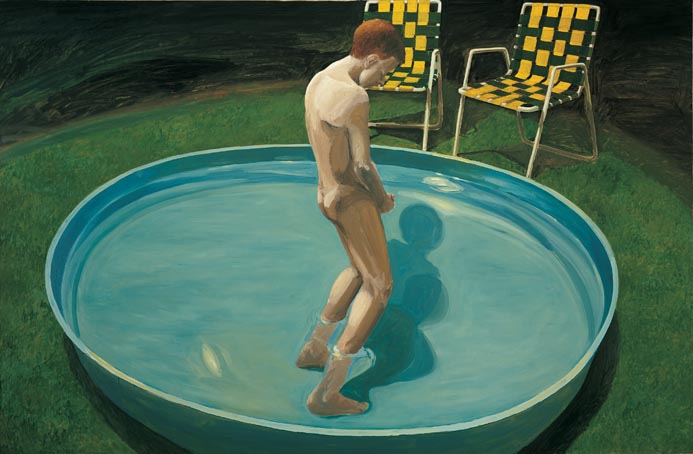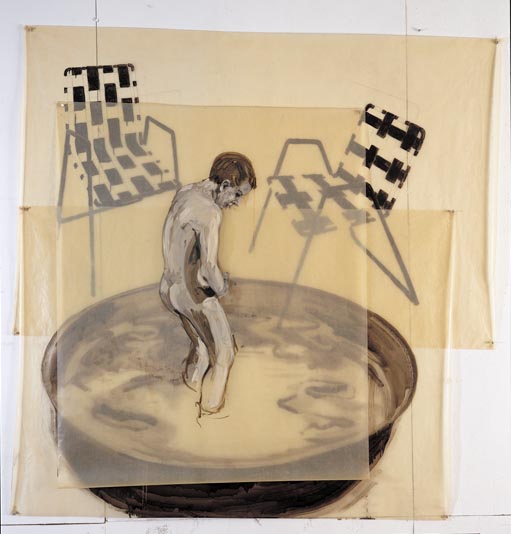Whitehot Magazine
April 2024
"The Best Art In The World"
"The Best Art In The World"
April 2024
August 2013: BOOK REVIEW - Eric Fischl's "Bad Boy: My Life on and off the Canvas"
 Sleepwalker, 1979, one of the first Eric Fischl paintings to gain notoriety and acclaim
Sleepwalker, 1979, one of the first Eric Fischl paintings to gain notoriety and acclaim
by Adev
Bad Boy: My Life on and off the Canvas, Eric Fischl and Michael Stone, Crown Publishers, May 2013, $28 U.S./$31 Canada
Eric Fischl’s new memoir Bad Boy, named after his milestone painting from 1981, takes the reader from Fischl’s childhood to the present day with lengthy asides on the artist’s development and process.
Admittedly, this review is somewhat overdue, owing to the difficulty of reviewing a prominent artist’s memoir. When I mentioned to a friend that I would be reviewing the book and described what I viewed as a particularly clunky passage towards the beginning, I was admonished to be kind in my review because my friend felt that critics had been unduly harsh with Fischl’s recent work (Ken Johnson’s March 1, 2012 New York Times review of “Eric Fischl: Recent Portraits” at Mary Boone Gallery notoriously began with the first line, “In recent years Eric Fischl has displayed a remarkable obliviousness to possible perceptions of his work.”)
In reviewing an artist’s autobiography, there is always the risk that criticism of the book will be mistaken for a judgment on the artist’s body of work. Most artists do not moonlight as fine writers, and there is really no reason to expect a quality any better than the memoirs of other celebrities. We do not expect Justin Bieber, Kanye West, or Snooki to dazzle us with their turn of phrase any more than we would expect Joan Didion or Zadie Smith to put on a great concert or make excellent reality show fodder. But artists are sensitive and do not generally savor the sentiment that their latest effort, in whatever medium, is aesthetically tone-deaf and lacking in execution.
Fischl is not a writer, having made his name as a figurative oil painter in the heady days of the 1980s New York art world. As Fischl discusses in his first chapter, he was given a blockbuster retrospective at the Whitney Museum in 1986, just five years after his first New York solo show. Presumably Fischl is not losing any sleep over his reputation as a writer.
Recognizing that he is not a writer, Fischl co-authored the book with a ghostwriter, Michael Stone, “whose crazy idea it was to write this memoir” Fischl says in the book’s Acknowledgements. Fischl apparent friendship with Stone explains the odd choice of a veteran crime reporter to write about a key figure in contemporary art. The only other book credit this reviewer could find for Stone was The Cell: Inside the 9/11 Plot and Why the FBI and CIA Failed to Stop It, Hyperion, 2002. One wonders whether we can now expect Marina Abramović to come out with a tell-all co-written with a retired editor from Bon Appetit.
Bad Boy begins at the beginning, describing the author’s troubled childhood in which his family maintained a membership at the local yacht club, Fischl attended a posh boarding school, and the family once briefly relocated to St. Tropez when his father invested in a Coca Cola bottling plant there. Fischl also tells us about his mother’s alcoholism and how his parents preferred to lounge about nude in their suburban home. Apart from those facts, the section of the book dealing with Fischl’s early life before he arrived in New York can be safely skipped. The writing is uneven and laborious, giving one the impression that each scene was painfully extracted from Fischl in shorthand and that neither co-author has actually read many memoirs. A good rule of thumb for the memoirist is to focus deeply on one or two themes, rather than providing a start-to-finish account of one’s life with equal time devoted to each period. That rule is not obeyed here, resulting in extraneous material that obscures the true gems that are in this book despite its flaws.
The chronologically ordered chapters are also separated by brief essays from Fischl’s friends, relatives, and colleagues. With a couple exceptions, including a piece by Fischl’s friend comedian/writer/banjo player Steve Martin, the essays are bland and do not add much to the book. After the first few, the essays feel like a heavy-handed technique for meeting a word count goal, with one to three essays appearing unfailingly after every short chapter.
The book is at its best and most interesting when Fischl describes his process in creating some of the key paintings in his career, including Sleepwalker, 1979, Bad Boy, 1981, and Saint Tropez, 1982. These are the moments when Fischl delivers and provides insights into his creative process that should prove worthwhile reading for even those who would not describe themselves as avid lovers of contemporary art. Fischl also addresses in detail his process for his controversial sculpture Tumbling Woman, Fischl’s memorial to the victims of 9/11, which was removed only two days after being put on display at Rockefeller Center in 2002, when New York was still raw and reeling. The book also includes fourteen pages of color insets with pictures of some of Fischl’s most widely known works.
Also worth reading are Fischl’s brief vignettes of various art world figures, from the sublime to the ridiculous. Fischl describes the New York art world of the 1980s, where Fischl saw Andy Warhol, Jean-Michel Basquiat, and Keith Haring giggling together over dinner at Mr. Chow’s. He also discusses his longtime gallerist Mary Boone, who was just beginning to make her name when she finally agreed to represent Fischl in 1984 after a lukewarm studio visit the year before. We are also treated to a story about a young Larry Gagosian locking an artist and a filmmaker in a restaurant’s broom closet one night, and given a glimpse into the career of Fischl’s wife, artist April Gornik, whose work focuses on dramatic landscapes. To some extent there is a parallel between the suburban voyeurism of Fischl’s most prominent paintings and the way in which Fischl writes about the art world. Fischl comes across as uneasy and reserved, as though he is an outsider pressing his face against the window despite his success.
 Eric Fischl with Mary Boone at the opening of the Krefeld Project, Krefeld, Germany
Eric Fischl with Mary Boone at the opening of the Krefeld Project, Krefeld, Germany
Much like his painted portraits, which are often described as unflattering renderings of their subjects, Fischl does not flinch in revealing his own flaws in Bad Boy. Fischl also makes no bones about people who have rubbed him the wrong way, and will not hesitate to hold a grudge against those he believes to have wronged him. Fischl dishes on his falling out with New York art critics Roberta Smith and Jerry Saltz, and writes insightfully on his tense relationship with fellow 1980s superstar painter Julian Schnabel, who appears shirtless in a photograph in the book, striking a comical muscle man pose in front of a Fischl painting featuring nude beachgoers. (Fischl and Schnabel seem to be on better terms these days, as Schnabel has contributed two short essays to the book. I won’t spoil it for you, but one involves arm wrestling.)
Fischl writes bluntly about his lack of respect for the work of contemporary artists Jeff Koons and Damien Hirst, whom he associates with turning the art world into the art market. On Koons, Fischl provides the wonderful quote that “his meticulously cultivated boyish enthusiasm and wide-eyed wonder is more reminiscent of Eddie Haskell than Beaver Cleaver.” Fischl also turns a skeptical eye to the way questionable art stars can be manufactured overnight, expressing concern with the practice of prominent collectors, dealers, and auction houses underwriting displays of contemporary art in which they have a financial interest in public institutions. Fischl is not afraid to state that “contemporary art ha[s] failed its audience on a basic level.” Also worth reading is Fischl’s refreshingly honest discourse on the contemporary art world’s preference for fashionable works devoid of emotion, works that are merely clever. Fischl seems most comfortable and genuine when he employs an essay style of writing to impart his views on the art world, and this is where his strengths as a writer seem to lie.
Bad Boy is worth perusing for Fischl’s meditations on his creative process and the state of the contemporary art world, but a cover-to-cover reading is probably not necessary. It will be interesting to see whether Fischl expands on his strengths and writes at more length on his views of the art world and other artists in the future.
 Eric Fischl, Study for Sleepwalker, oil on paper
Eric Fischl, Study for Sleepwalker, oil on paper

Adev
Adev is an accomplished equestrienne, metallurgist, and Time Magazine's Person of the Year for 2007. Adev reviews books for Whitehot Magazine.










